Directions (1-4): In the question below, few statements are given followed by two conclusions numbered I, and II. You have to take the given statements to be true even if they seem to be at variance with commonly known facts. Read all the conclusions and then decide which of the given conclusions logically follows from the given statements disregarding commonly known facts.
Q1. Statements: Some Pens are Erasers.
Only a few Erasers are Sharpeners.
All Sharpeners are Copies.
Conclusions: I. Some Pen being Sharpener is a possibility.
II. Some Erasers are not Copies.
(a) If only conclusion I follows
(b) If only conclusion II follows
(c) If either conclusion I or conclusion II follows
(d) If both conclusions I and II follow
(e) If neither conclusion I nor conclusion II follows
Q2. Statements: No Dress is Western.
Only a few Westerns are Indians.
All Indians are Traditional.
Conclusions: I. No Dress isIndians
II. Some Traditional are not Dresses
(a) If only conclusion I follows
(b) If only conclusion II follows
(c) If either conclusion I or conclusion II follows
(d) If both conclusions I and II follow
(e) If neither conclusion I nor conclusion II follows
Q3. Statements: Only a few Beautiful are Smart.
All Smart are Handsome.
No Handsome are Ugly.
Conclusions: I. Some Beautiful can never be Ugly
II. No Smart is Ugly
(a) If only conclusion I follows
(b) If only conclusion II follows
(c) If either conclusion I or conclusion II follows
(d) If both conclusions I and II follow
(e) If neither conclusion I nor conclusion II follows
Q4. Statements: No Iran is Bhutan.
Only a few USA are UK.
No UK are Iran.
Conclusions: I. Some UK are not USA
II. Some Bhutan are USA
(a) If only conclusion I follows
(b) If only conclusion II follows
(c) If either conclusion I or conclusion II follows
(d) If both conclusions I and II follow
(e) If neither conclusion I nor conclusion II follows
Direction (5-8): In the question below, few statements are given followed by two conclusions numbered I, and II. You have to take the given statements to be true even if they seem to be at variance with commonly known facts. Read all the conclusions and then decide which of the given conclusions logically follows from the given statements disregarding commonly known facts.
Q5. Statements: No Cat is Dog.
Only a few Cats are Goats.
Some Goats are not Rats.
Conclusions: I. Some Goats are Rats.
II. No Rat is Cat.
(a) If only conclusion I follows
(b) If only conclusion II follows
(c) If either conclusion I or conclusion II follows
(d) If both conclusions I and II follow
(e) If neither conclusion I nor conclusion II follows
Q6. Statements: No Cat is Dog.
Only a few Cats are Goats.
Some Goats are not Rats.
Conclusions: I. All Rats being Goat is a possibility.
II. Some Rats are Cats.
(a) If only conclusion I follows
(b) If only conclusion II follows
(c) If either conclusion I or conclusion II follows
(d) If both conclusions I and II follow
(e) If neither conclusion I nor conclusion II follows
Q7. Statements: No Pepsi is Mojito.
Some Drinks are Mojito.
Only a few Lemonades are Mojito.
Conclusions: I. All Mojito being Lemonade is a possibility.
II. Some Drinks being Lemonade is a possibility.
(a) If only conclusion I follows
(b) If only conclusion II follows
(c) If either conclusion I or conclusion II follows
(d) If both conclusions I and II follow
(e) If neither conclusion I nor conclusion II follows
Q8. Statements: Some Vowels are Letters.
Only a few Letters are Consonants.
All Consonants are Numbers.
Conclusions: I. Some Vowels can never be Numbers
II. Some Letters are Numbers
(a) If only conclusion I follows
(b) If only conclusion II follows
(c) If either conclusion I or conclusion II follows
(d) If both conclusions I and II follow
(e) If neither conclusion I nor conclusion II follows
Direction (9-12): In the question below, few statements are given followed by two conclusions numbered I, and II. You have to take the given statements to be true even if they seem to be at variance with commonly known facts. Read all the conclusions and then decide which of the given conclusions logically follows from the given statements disregarding commonly known facts.
Q9. Statements: No Fig is Peach.
Only a few dates are Figs.
No Orange is Peach.
Conclusions: I. Some Peaches are dates.
II. Some Figs are not dates.
(a) If only conclusion I follows
(b) If only conclusion II follows
(c) If either conclusion I or conclusion II follows
(d) If both conclusions I and II follow
(e) If neither conclusion I nor conclusion II follows
Q10. Statements: All Dogs are barking.
Only a few lions are tiger.
No tigers are barking.
Conclusions: I. All Lions are barking.
II. The Lions which are tiger can never be barking.
(a) If only conclusion I follows
(b) If only conclusion II follows
(c) If either conclusion I or conclusion II follows
(d) If both conclusions I and II follow
(e) If neither conclusion I nor conclusion II follows
Q11. Statements: All Dogs are barking.
Only a few lions are tiger.
No tigers are barking.
Conclusions: I. All tigers are dogs.
II. Some lions are dogs.
(a) If only conclusion I follows
(b) If only conclusion II follows
(c) If either conclusion I or conclusion II follows
(d) If both conclusions I and II follow
(e) If neither conclusion I nor conclusion II follows
Q12. Statements: All Months are May.
No May is 2022.
Only a few 2022 is Hot.
Conclusions: I. Some May is Hot.
II. No May is Hot.
(a) If only conclusion I follows
(b) If only conclusion II follows
(c) If either conclusion I or conclusion II follows
(d) If both conclusions I and II follow
(e) If neither conclusion I nor conclusion II follows
Direction (13-15): In the question below, few statements are given followed by two conclusions numbered I, and II. You have to take the given statements to be true even if they seem to be at variance with commonly known facts. Read all the conclusions and then decide which of the given conclusions logically follows from the given statements disregarding commonly known facts.
Q13. Statements: Only a few Water is Milk.
Only a few Milk is Alcohol.
No Alcohol is Sanitizer.
Conclusions: I. Some Milk is not Sanitizer.
II. Some Water is not Milk.
(a) If only conclusion I follows
(b) If only conclusion II follows
(c) If either conclusion I or conclusion II follows
(d) If both conclusions I and II follow
(e) If neither conclusion I nor conclusion II follows
Q14. Statements: All Swans are Pigeons.
Only a few Pigeons are Parrots.
Some Parrots are not Peacocks.
Conclusions: I. Some Pigeons are not Peacocks.
II. No Swans are Parrots
(a) If only conclusion I follows
(b) If only conclusion II follows
(c) If either conclusion I or conclusion II follows
(d) If both conclusions I and II follow
(e) If neither conclusion I nor conclusion II follows
Q15. Statements: Some Rabbits are not Lions.
Only a few Lions are Panthers.
No Panthers are Leopards.
Conclusions: I. Some Rabbits are not Panthers.
II. Some Lions are not Leopards.
(a) If only conclusion I follows
(b) If only conclusion II follows
(c) If either conclusion I or conclusion II follows
(d) If both conclusions I and II follow
(e) If neither conclusion I nor conclusion II follows
Solutions
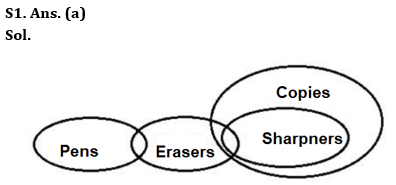
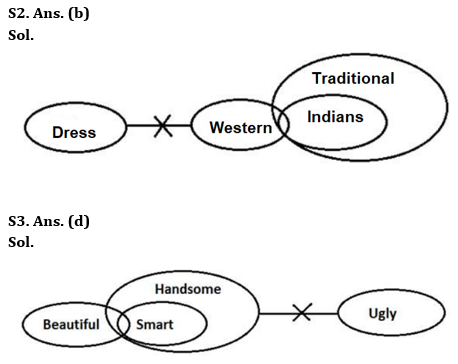
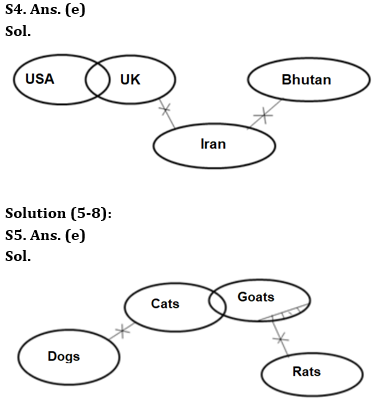
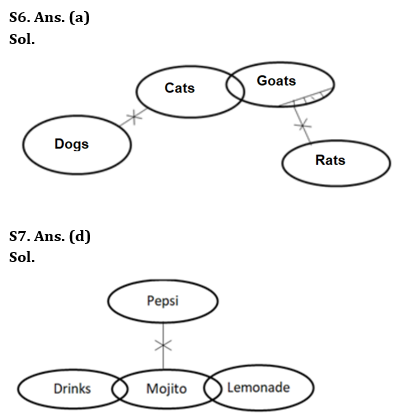
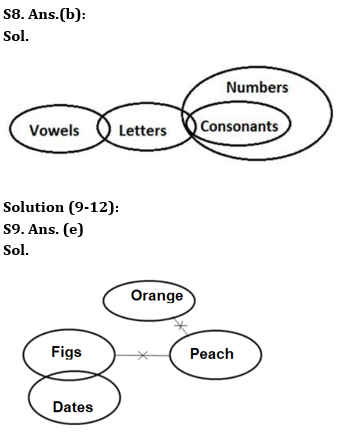
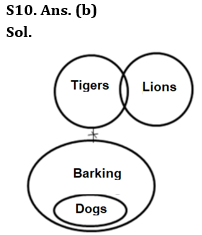
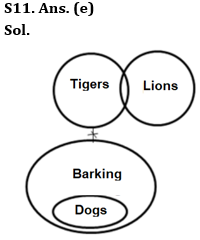
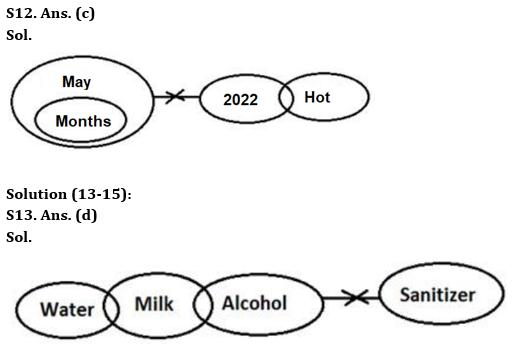
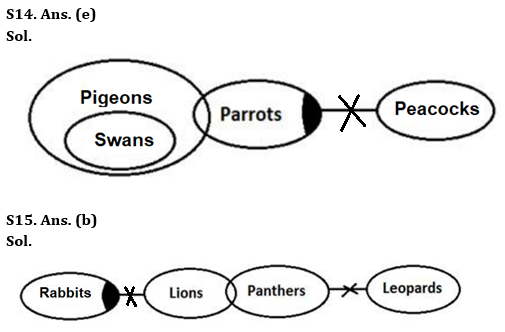





 GA Capsule for SBI Clerk Mains 2025, Dow...
GA Capsule for SBI Clerk Mains 2025, Dow...
 The Hindu Review October 2022: Download ...
The Hindu Review October 2022: Download ...
 IIFCL Assistant Manager Result 2025 Out,...
IIFCL Assistant Manager Result 2025 Out,...





